abstract
Maps, mazes, myths, magic, and mathematics, computation, cognition, community, and the constructed environment, all reveal something of our internal models of space. Whilst the spaces we inhabit have many objective properties, we only perceive and process certain of these, and add many social and subjective qualities of our own. In fairy tales and science fiction, some of the "real" properties are let slip, yet the worlds remain comprehensible. Studying the essential and nonessential qualities of space can guide the construction and navigation of information spaces. However, the very idea of information spaces, and indeed cyberspace, presupposes that spatial metaphors can make sense of information. This chapter explores the relationships between our understandings of physical space and conceptual spaces; from childhood memories, to transarticulation, the way words shape our conceptual and physical landscape, we will see that our understandings of space and of knowledge itself are similarly shaped.. pace and of knowledge itself are similarly shaped.


